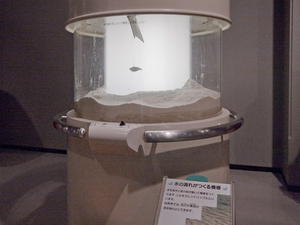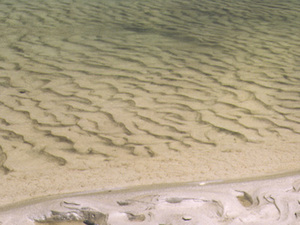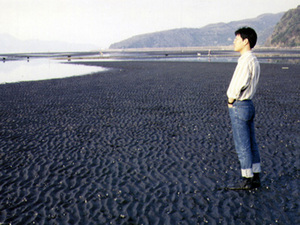Nagoya City Science Museum
TOP > Exhibition Guide > Keyword Search > Starting with "E" > environment > Current ripple
Current ripple



Purpose of Exhibition
This exhibit is designed to show you how water currents move sand particles to create ripples in the hope that this demonstration will interest you and prompt you to observe current ripples as a way to enhance your intellectual curiosity in the outdoor life.
Additional Knowledge
Undulations are occurring at the bottom. Such water current-caused small odd-shaped topographies at the sand bottom are called "current ripples", which are often seen at the river bottoms. Let's watch the movements of the sand particles.The sand particles are moved at the peaks of the ripples and on the upper current side, and they accumulate on the slopes on the lower current side. This phenomenon is repeated. Obviously, the peaks and troughs of the ripples are constantly shifting. A change in water current velocity gradually transforms the shapes of the ripples. A change in sand particle size also does the same.Ripples are caused by waves as well as water currents, and are called "wave ripples", which differ in shape and are characterized by a good symmetric property in terms of cross-sectional shape. With regard to wave ripples, you are introduced to them in the Earth Laboratory. Waves and currents often occur simultaneously. So in reality, the shapes are in between those of current ripples and wave ripples (namely, "composite stream ripples"). Those ripples often remain in the stratum and are used to figure out the past environment in which the stratum was formed.
Cross-Section of Current Ripples (Photo: by Miwa Yokokawa) Current Ripples (Ozoe River in Fukui-ken / Photo: by Miwa Yokokawa)Wave Ripples (Photo: by Miwa Yokokawa)Wave Ripples (in Kumamoto-ken / Photo: by Miwa Yokokawa)
Article by Shoji Nishimoto, curator
